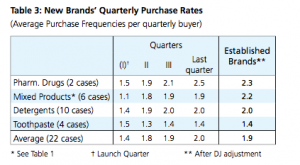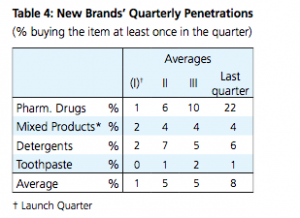When launching a new brand or product, marketing teams often worry about the need to build loyalty of the new launch. The assumption is that the brand or product will have to fight to build frequency of purchase as it is less familiar than established rivals with a loyal following. But is this really the case? Well, it seems not, according to research on 23 successful new brands or line extensions by Andrew Ehrenberg and Gerald Goodhardt (the study is quite old, from 2000, but I think the findings are still valid). Thanks to Bruno Romano for sharing the research with me.
1. ‘Near-instant’ loyalty
The main finding from the research is that ‘a successful new brand’s average purchase rate was at or near its subsequent “normal” level and also equal to the rates for established brands, virtually from the start.’ The data below shows how the average frequency of purchase* changes over the first four quarters of the new launch. We can see that after the initial, ‘turbulent’ launch quarter purchase frequency quickly builds up to the same level as established products.
* NOTE: average purchase frequency has been widely shown to correlate closely with other loyalty measures, such as the incidence of 100%-loyal buyers and share of category requirements.

2. Penetration is king (again)
So, what drives the growth of new brands, given that loyalty levels don’t change much after the launch quarter? The answer is, as regular readers will know, all about penetration. Looking at the table below, we can see that the penetration in the fourth quarter was eight times the level of the launch quarter. The key to a successful new brand or product is not trying to influence loyalty. Rather, the priority should be on building mental and physical availability to drive trial and so boost penetration.

3. Implications for new launches
What are the implications of near-instant loyalty for new brand or product launches? I suggest the following points to keep in mind:
- Drive trial: this was one of the first things we were trained to do at P&G. Any new launch plan needed a qualitatively backed-up plan to drive trial, using devices such as sampling and coupons.
- Work on distinctiveness: many new brands or products are evaluated using concept testing. But getting a good score when a consumer is ‘force-exposed’ to a written concept is not the same as getting noticed in the real world. Therefore, start work early on the distinctive brand properties (symbols, colours, slogans, music etc.) that will help you get noticed.
- Cut loyalty programs: re-consider any launch plans focused on driving loyalty, such as extra free packs or loyalty programs/clubs. Focus all efforts on driving trial.
- Drive distribution: achieving wide distribution and good in-store visibility is crucial to drive penetration and its importance cannot be over-stated. Smart marketers work hand-in-hand with sales teams to ensure the best possible ‘pitch’ of the new brand or product.
In conclusion, this study confirms that the importance of penetration over brand loyalty applies not only to established brands, but also to new brands and products.